The Chambo Fisheries Research project is aimed at providing the Malawian Government with a new management plan for the artisanal, semi-industrial and industrial fisheries on Lake Malombe, the Upper Shire river and the south-east arm of Lake Malawi.
When the project started in 1988, little was known about the state of the fisheries. From fishing regulations, which were prepared on the basis of biological research in the mid 1970s, neither adequate extension messages have been drawn nor has enforcement of the existing laws ever been carried out efficiently, mainly owing the limited personnel and financial resources of the Fisheries Department.
Since its beginning the Chambo Fisheries Research project has initiated a series of research activities to obtain information on the biology of chambo, the most valuable fish caught in the project area, to assess the fish stocks in the above mentioned water bodies and to assess the economic well-being of the fisherfolk and people involved in fishing-related activities. The latter includes surveys, which were aimed at the assessment of the profitability of fishing.
The present report presents results of studies on costs and earnings of fishing operations, which were carried out in the artisanal as well as the semi-industrial sector of the fishery, mainly to assess the present status of the fishery and to give a basis for prediction of the impact of new fisheries management measures.
For limnological and logistic reasons the project area is divided into two major and eight minor strata (MS). The Chambo Fisheries Research project carried out a frame survey in January 1990 (Alimoso et al, 1990), primarily to obtain information on the number of landing sites, the number and distribution of fishing equipment and people involved in fishing. The results were compared to those from frame surveys, undertaken annually by the Fisheries Department and utilized to design an efficient method for catch/effort sampling (Alimoso et al, 1991).
It was decided to use this data collection system to obtain information on variable costs of fishing in the artisanal fishery. A special questionnaire was designed, field-tested and attached to the one used for catch/effort sampling. The questionnaire includes detailed questions about the variable costs of fishing (apart from costs of net maintenance) and the number of crew operating the net, because an uniform sharing system between fisherman entrepreneur and crew does not exist for the different types of fishing units and often the crew size varies according to the size of the net.
Information on costs of net maintenance were collected for a sub-sample.
Information on earnings (catch value) were obtained by processing the catch and beach price data collected in the catch/effort survey, using a data base (MTF).
The Upper Shire area was excluded from the costs survey due to labour force limitations.
The studies on costs and earnings were carried out between January and December 1991. The data collection was closely monitored by the socio-economist of the project.
The data on variable costs of fishing were analysed with Lotus 1–2–3 programme.
For studies on costs and prices in the semi-industrial sector of the fishery, out of the total number of six pair trawl license holders, which were reporting their catches to the Fisheries Department in 1991, three were chosen at random for interviews. The interviews were carried out, with a guideline, in February 1992.
Catch data and information on the number of fishing days per year were obtained from Fisheries Department's statistics.
a) Prices
The beach price of chambo has almost doubled in 1991, possibly as a result of the collapse of the chambo stocks in this lake (Van Zalinge et al, 1991). The price for kambuzi increased only according to the inflation rate, but shows large seasonal variations. (fig. 1 a,b) (for detailed price information and beach prices of other species see Mdaihli et al, 1992).
Figure 1: Beach prices, Lake Malombe
a) Chambo
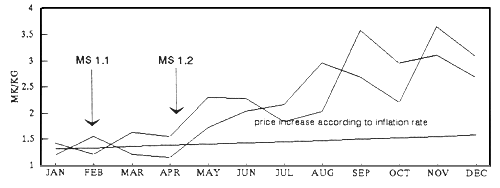
b) Kambuzi
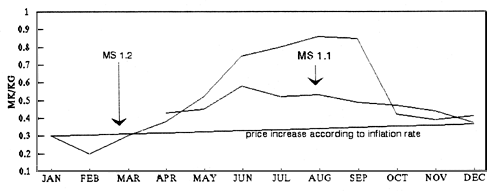
b) Economic importance of Lake Malombe for the Malawian economy
Costs and earnings of the artisanal fishery on Lake Malombe were calculated for 4 chambo seine nets, 186 nkacha nets, 56 kambuzi seine nets and 491 gillnets (Fisheries Department's annual frame survey from August 1990). The most recent frame survey from August 1991 recorded 219 nkacha nets, 84 kambuzi seine nets, 6 chambo seine nets and 402 gillnets. The number of fishing units has increased, but the number of fisherman entrepreneurs has remained almost stable. At present there are 326 fisherman entrepreneurs fishing with 2405 crew in 29 fishing villages. These fishermen contribute 60% (MK6 million) to the overall economic output of the three water bodies in the project area. Chambo, the most important fish in respect of amount caught and value produced in the past, has lost its importance and has been replaced by a variety of small food fish (tab. 1).
Table 1: Contribution of the different types of fish to the overall economic output of Lake Malombe
| Species | Catch value (MK*1000) |
| Kambuzi | 3,250 |
| Chambo | 950 |
| Mbaba | 940 |
| Mlamba | 330 |
| Tilapia apart from chambo | 220 |
| Ntchila | 180 |
| Kampango | 100 |
| Usipa | 5 |
| Mpasa | 1 |
| Sanjika | 1 |
| Utaka | 0.5 |
| Others | 110 |
| Total | 6,081 |
Costs from all fisheries combined do not reach MK 2 million, which leaves a gross income of more than MK 4 million for the fisherman-entrepreneurs. However, earnings are not evenly distributed.
The nkacha fishery is the most important fishery in Lake Malombe, in terms of people employed and economic output. It accounts for 62% of Lake Malombe's overall produce, followed by the gillnet fishery (21.5%), the kambuzi seine fishery (15%) and the chambo seine fishery (1.5%).
c) Profitability of fishing in Lake Malombe
For the individual fisherman-entrepreneur nkacha net fishing is the most profitable technique in Lake Malombe, followed by chambo seining, kambuzi net fishing and gillnetting (tab. 2).
Table 2: Gross income in Lake Malombe (MK * 1000)
| NK | CS | KS | GN | |
| Total produce | 3,774 | 85 | 913 | 1,309 |
| Total costs | 1,018 | 36 | 318 | 398 |
| Total gross income | 2,756 | 49 | 595 | 911 |
| Annual gross income per entrepreneur | 15 | 12 | 11 | 8 |
Note: All fishing units are fully depreciated; costs for net maintenance were not taken into account; it is estimated that each net requires netting material for about MK 1000 per year; gross income here means catch value minus crew share minus misc. costs.
Small and large haplochromines (kambuzi and mbaba) are the main income earners for the nkacha net fishermen (fig. 2).
Figure 2: Earnings composition of nkacha nets

These fishermen are very active throughout the year. It was found that they even continue fishing undiminishingly during the closed season (January – March), which however is not reflected in our data, as collection was nearly impossible. Months with the highest earnings are April, July and August (fig.3).
Figure 3: Seasonal change in earnings composition of nkacha nets
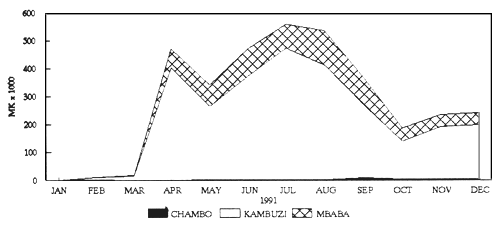
In the peak season, fishermen go out fishing up to 25 days per month and they make up to 20 pulls per fishing day. The catch per pull is higher than in other months of the year (up to 23 kg of fish).
The sharing system between fisherman entrepreneur and crew in the nkacha fishery is not uniform, but two major sharing arrangements have been identified, namely 2:1 in minor stratum (MS) 1.1 and 3:1 in minor stratum (MS) 1.2. Apart from the crew share entrepreneurs have to cover costs for warps, which have to be replaced almost every fishing day (MK 0.50/day) and for food for the crew (MK 4.50/day). Some entrepreneurs deduct these expenditures from the crew share.
Kambuzi seine fishermen fish for the same types of fish as nkacha net fishermen (fig. 4)
Figure 4: Earnings composition of kambuzi seine nets
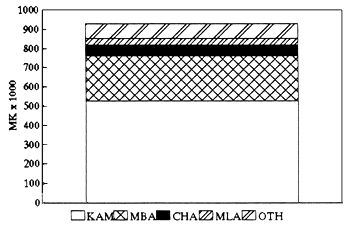
Chambo contributes only 1.9% to the total catch of kambuzi seine nets and 6.7% to the total earnings and is only important from October to December (fig. 5).
Figure 5: Seasonal change in earnings composition of kambuzi seine nets
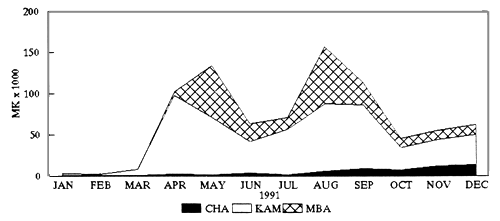
Note: No data for Jan–March due to closed season
The kambuzi seine net entrepreneurs share the catch with the crew mainly 2:1. Other costs of fishing include kerosene (MK 0.80/day), batteries (MK 1.50/day), warps (MK 4.5/day), firewood (MK 2/day), pressure lamp mantle (MK 0.5/day) and sometimes food for the crew (MK 4.5/day).
Chambo accounts for 40% of the total gillnet catch, and for more than 50% of the total earnings of gillnet fishermen (fig. 6)
Figure 6: Earnings composition of gillnets

Mlamba, ntchila and other tilapiine species (OTT) also play an important role as income earners, especially in times of low or irregular chambo catches (fig. 7).
Figure 7: Seasonal change in earnings composition of gillnets
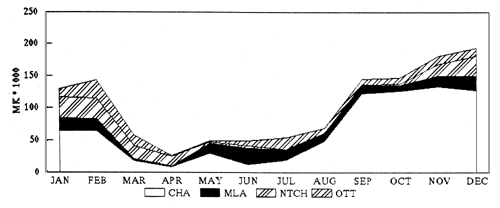
Gillnet fishermen are permitted to fish throughout the year. The activity level is generally high and stable, excluding months with low chambo catches. The catch per unit of effort (cpue) is extremly high in MS 1.2, with catches up to 70kg/100m net, whereas in MS 1.1 the mean cpue is 6kg. Fisherman entrepreneurs and crew seem to have two major sharing arrangements: 3:1 in minor stratum 1.1 and 2:1 in minor stratum 1.2. Other expenditures include kerosene (MK 0.40/day), warps (MK 0.10/day), crewfood (MK 2/day) and pressure lamp mantle (MK 0.10/day). The gillnet fishery is less profitable than the other fisheries in Lake Malombe, but still successful enough to keep the people involved in business.
The chambo seine fishery is unimportant considering the small number of people involved and its minor contribution to Lake Malombe's overall production. Only 100 fishermen (FE + crew) are still involved in this kind of fishing. Chambo and other tilapiine species, which fetch a high price on the market, constitute the economically most important part of the chambo seine fishermen's catches. The sharing system between fisherman entrepreneur and crew seems to follow the ratio 1:1. Other costs of operation include expenditures for batteries (MK 3/day), kerosene (MK 2/day), warps (MK 20/day), firewood (MK 4/day), crewfood (MK 5/day) and mantle (MK 1.5/day). Although rather inactive with only 100 fishing days per year, the chambo seine owners are the second most economically successful fishermen in Lake Malombe.
d) Bio-economic model for the kambuzi fishery
Based on kambuzi catch predictions (Schaefer model) an economic model is given, which shows the relationship between the total earnings (catch value), the total costs and profit of the fishery, the mean annual profit per fisherman entrepreneur and the annual wages of the individual crew members. For the model, the kambuzi seine and nkacha fishery is combined. The value of the catch is based on a mean beach price of MK .60/kg. For the catch related variable costs a fixed sharing system between the entrepreneur and the crew of 2:1 is assumed. The more effort-related miscellaneous costs are taken from the costs and earnings studies.
Annual costs for net maintenance are fixed at MK 1000 per net. The activity level is assumed to be constant for all effort levels. The model shows that the maximum profit for the whole fishery is reached at an effort level of 180 nets. Any additional net contributes more to the total costs than to the total earnings. The maximum catch value (MSE) for the fishery is reached at an effort level of 195 nets. With more nets than this, the fishery remains profitable until an effort level of 350 nets is reached, but the annual profit per net drops down to MK 300. At this stage the crew wages becomes the limiting factor. The fisherman can choose between either closing his business or increasing the crew share, which would reduce his profit further (fig. 8)
Figure 8: Bio-economic model for the kambuzi fishery in Lake Malombe
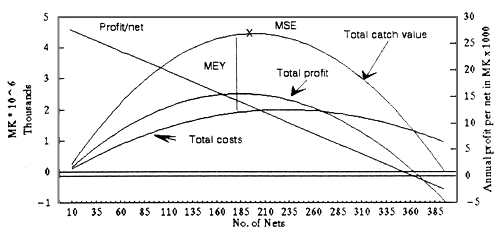
Note: Total costs do not increase proportionally to total effort, as the crew share depends on the catch
The total economic output of the Upper Shire River has declined from around 1.5 million in the early 1980s to MK 340.000 in 1991 (in 1991 prices) owing the collapse of the chambo stocks (tab. 3). The project frame survey in January 1990 (Alimoso et al, 1990) recorded 113 fisherman entrepreneurs and 1059 crew members, operating 3 gillnets, 78 chambo seine nets, 12 kambuzi seine nets and 34 nkacha nets. Since then, the number of fishermen has declined by 30%.
Table 3: Contribution of the different types of fish to the overall economic output of the Upper Shire river
| Species | Catch value (MK*1000) |
| Kambuzi | 196 |
| Chambo | 133 |
| Other tilapia | 3.6 |
| Kampango | 1.5 |
| Mbaba | 1.2 |
| Mlamba | 0.7 |
| Others | 2 |
| Total | 338 |
Detailed cost breakdowns for the Upper Shire are not available, but earnings analysis shows that kambuzi seine, chambo seine and gillnet operations run at a loss (tab. 4).
Table 4: Economic performance of fishing on the Upper Shire River (MK)
| Gear | annual catch value/net |
| Gillnet | 560 |
| Chambo seine | 1,700 |
| Kambuzi seine | 140 |
At present, only the nkacha fishery is operating at a reasonable profit margin - most of these nets are located at the southern part of the river and it is believed that they fish mainly in Lake Malombe. Assuming a sharing system of 2:1 between fisherman-entrepreneur and crew and using cost figures from nkacha fishing in Lake Malombe it is estimated that nkacha fishermen in the Upper Shire area make a profit of approx. MK 2400 per annum.
a) Economic importance of the artisanal fishery in the south-east arm of Lake Malawi
The project frame survey recorded 702 fisherman-entrepreneurs and 5586 crew members operating 249 gillnet fishing units, 293 chirimila nets, 49 chambo seine nets, 108 kambuzi seine nets and 38 nkacha nets in the south-east arm of Lake Malawi in 1990 (Alimoso et al, 1990). Although the number of fishing units is much higher here than in Lake Malombe, the south-east arm produces only 40% of the total economic output of the water bodies in the project region. Chambo, the most valuable fish in the project area, accounts for 23% of the total catch of the artisanal fishermen, but for 46% of the total catch value. Kambuzi, the second important fish, contributes 35% to the total catch, but only 25% to the total economic output of the artisanal fishery (fig. 9).
Figure 9: Contribution of different types of fish to the total economic output of the south-east arm of Lake Malawi

| CHA | Chambo |
| KAM | Kambuzi |
| UTA | Utaka |
| USI | Usipa |
| MBA | Mbaba |
| MCH | Mcheni |
| KMG | Kampango |
| MLA | Mlamba |
| OTH | Others |
Both chambo and kambuzi beach prices have increased faster than the rate of inflation (fig. 10).
Figure 10: Beach prices, south-east arm of Lake Malawi
a) Chambo

b) Kambuzi

Chambo is the most important fish in MS 2.1 and MS 2.2, whereas kambuzi, utaka and usipa constitute the main part of the catch in MS 2.4 and MS 2.5. Fishing activities in MS 2.3 appear to be rather unsuccessful. This minor strata produces only a little more than 3% of the total catch value of the south-east arm (fig. 11).
Figure 11: Earnings composition and contribution of the different minor strata to the overall economic output of the arisanal fisheries in the south-east arm
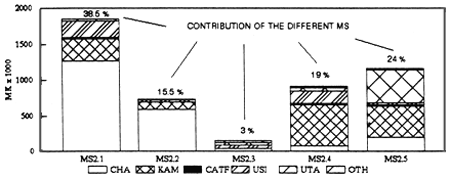
| CHA | Chambo |
| KAM | Kambuzi |
| CATF | Catfish |
| USI | Usipa |
| UTA | Utaka |
| OTH | Others |
b) Comparison of the profitability of the different artisanal fishing techniques in the south-east arm of Lake Malawi
Chirimila netting is the economically most important fishing technique in the south-east arm, followed by gillnetting, chambo seining, nkacha netting and kambuzi seine fishing (tab. 5).
Table 5: Economic importance of the different fishing techniques
| Gear | total catch (t * 1000) | total earnings (MK * 1000) |
| Chirimila net | 2,387 | 1,632 |
| Gillnet | 660 | 1,056 |
| Chambo seine | 552 | 912 |
| Nkacha net | 801 | 624 |
| Kambuzi seine | 1,003 | 576 |
For the individual fisherman-entrepreneur the profitability of chirimila fishing is generally low (tab. 6). In MS 2.1, where most entrepreneurs use outboard engines (72%), the annual gross income does not reach MK 1500. Figures for MS 2.3 indicate that fishermen do not make any profit at all. Chirimila fishing here is very seasonal. The mean number of fishing days per year is low as is the number of pulls per fishing day. The operational cost are high due to the use of outboard engines. In MS 2.4 several factors contribute to the success of the fishermen. The mean cpue is high and stable throughout the year and fishermen are able to operate almost 100 days per year with up to 11 pulls per fishing day.
Although the gillnet fishery contributes substantially to the overall production of the south-east arm of Lake Malawi, for the individual fisherman this technique does not appear to be profitable. The highest profits are made in MS 2.1 where the fishermen own large gillnets and work almost 260 days per year to compensate for the low cpue. In MS 2.5 entrepreneurs operate their units without an assistant, which keeps the costs of operation low.
A comparison between minor strata shows large variations in the profitability of chambo seining. Chambo seine fishermen in MS 2.1 and MS 2.2 are the most successful artisanal fishermen in the whole project area. High chambo catches per pull, high chambo prices and the opportunity to fish more than 100 days a year make this fishery extremly lucrative.
The nkacha net fishery does not appear to be resident in the south-east arm. The project frame survey recorded 38 nkacha nets in the south-east arm in January 1990, while the annual frame survey of the Fisheries Department, undertaken 6 month later, did not count any. It is believed that nkacha fishermen are very mobile and move, especially during closed seasons, which are different in Lake Malombe and the south-east arm of Lake Malawi, from one lake to the other.
Although kambuzi seine fishermen use increasingly smaller mesh sizes (mean 15mm) and the headline length of their nets is far greater than the maximum legal length, the profitability of kambuzi seining remains low. Increasing the mesh size to 25mm, which could be considered as a fisheries management option, would leave most kambuzi seine fishermen without any profit. A mesh size increase would result in a kambuzi catch decline of 17% and Usipa, the second most important fish caught in kambuzi seine nets, would not be caught anymore.
Table 6: Profit comparison for the different fishing
techniques in the different minor strata
(for 1991 on the basis of 1991 prices)
| Gear | CH | GN | CS | NK | KS | |
| Fishing days (/Yr/net) | MS 2.1 | 117 | 266 | 87 | 111 | 180 |
| MS 2.2 | 86 | 163 | 98 | 144 | 63 | |
| MS 2.3 | 26 | 124 | 1 | 0 | 57 | |
| MS 2.4 | 91 | 118 | 0 | 187 | 66 | |
| MS 2.5 | 111 | 115 | 13 | 0 | 75 | |
| Earnings (/yr/net) (MK*1000) | MS 2.1 | 9.5 | 10.1 | 34.5 | 9.5 | 13 |
| MS 2.2 | 10.1 | 2.3 | 19.3 | 10.4 | 2.8 | |
| MS 2.3 | 0.9 | 2.3 | 2 | 0 | 0.9 | |
| MS 2.4 | 10.6 | 2.1 | 0 | 27.6 | 2.5 | |
| MS 2.5 | 6.6 | 2.4 | 2.1 | 0 | 4.1 | |
| Costs (var) (/yr/net) (MK*1000) | MS 2.1 | 8.3 | 7.9 | 16 | 5.3 | 10.9 |
| MS 2.2 | 6.2 | 1.6 | 8.5 | 4.7 | 2.1 | |
| MS 2.3 | 1 | 2 | 1.3 | 0 | 1.6 | |
| MS 2.4 | 5.1 | 1.7 | 0 | 11.8 | 1.3 | |
| MS 2.5 | 2.6 | 0.3 | 0.2 | 0 | 1.9 | |
| Income (gross) (/yr/net) (MK*1000) | MS 2.1 | 1.2 | 2.2 | 18.5 | 4.2 | 2.1 |
| MS 2.2 | 3.9 | 0.7 | 10.8 | 5.7 | 0.7 | |
| MS 2.3 | -0.1 | 0.3 | 0.7 | 0 | -0.7 | |
| MS 2.4 | 5.5 | 0.4 | 0 | 15.8 | 1.2 | |
| MS 2.5 | 4 | 1.1 | 1.9 | 0 | 2.2 | |
Note: Costs of net maintenance are not included, because these data were not sufficiently accurate. It is estimated that each net requires netting material worth MK500–MK1000 per year. For the calculation above it is assumed that all nets are fully depreciated. For costs of investment see Appendix.
Main target species of the semi-industrial fishermen are chambo and chisawasawa. There are seven pair trawl units operating in the south-east arm of Lake Malawi at present, out of which six report their catches and days of operation frequently to the Fisheries Department (tab. 7). The earnings in this sector of the fishery are not evenly distributed. Only two fishermen managed to go out fishing more than 250 days in 1991. The operations of the others are hampered by the conditions of their engines, which are old and often break down.
Table 7: Catches and catch value in the semi-industrial sector of the fishery (1991)
| Catches (t) | ||||||
| No | fishing days/yr | Chambo | Chisawasawa | Utaka | Catfish | Others |
| 1 | 263 | 24.750 | 286.575 | 8.400 | 16.425 | |
| 2 | 258 | 23.875 | 261.375 | 5.500 | 19.050 | |
| 3 | 122 | 3.850 | 93.625 | 2.175 | 5.275 | |
| 4 | 121 | 12.075 | 185.070 | 5.075 | 5.375 | |
| 5 | 31 | 1.325 | 24.450 | 0.775 | 1.325 | |
| 6 | 29 | 0.750 | 3.285 | 18.300 | 0.050 | 0.675 |
| Beach prices | MK2.4/kg | MK0.6/kg | ||||
| Total | MK * 1000 | |||||
| Value | 159.900 | 512.628 | 10.980 | 13.185 | 28.875 | |
| Total produce all species 725.568 | ||||||
An operations model is given for an semi-industrial fisherman who fishes 260 days/year in Area A of the south-east arm of Lake Malawi (tab. 8). This (model) fisherman has been recently provided with a loan of MK 100,000 from a development finance institution at the following conditions:
The model shows the economic performance in 1991. Any prediction for the future can not be given, because a significant relationship between catch and effort for the stocks exploited by the semi-industrial fishermen could not be found.
Table 8: Operations model for a pair trawl fishing unit (MK)
| COSTS | ||||||
| Fixed costs | Total | |||||
| Wages | ||||||
| 2 head fishermen | 1,920 | |||||
| 8 crew members | 4,800 | |||||
| 2 watchmen | 960 | |||||
| 2 cleaners | 960 | |||||
| 1 manager | 3,000 | |||||
| Loan repayment | 25,000 | |||||
| Interest on loan capital | 18,000 | |||||
| Licence + registration | 762 | |||||
| Depreciation | 2,000 | 57,402 | ||||
| Variable costs | ||||||
| Diesel | 52,000 | |||||
| Oil | 3,640 | |||||
| Grease | 260 | |||||
| Crew incentive | 3,900 | |||||
| Repairs: | ||||||
| Boat/engine | 3,600 | |||||
| Nets | 4,800 | 68,200 | ||||
| Total costs | 125,602 | |||||
| REVENUES | ||||||
| Sales of chambo | 57,300 | |||||
| Sales of chisawasawa | 156,825 | |||||
| Sales of others | 14,730 | 228,855 | ||||
| PROFIT | 103,253 | |||||
On the basis of cpue-data from other fishing grounds in Lake Malawi a comparative model has been prepared, which shows, that pair trawl fishing is most profitable in Area A (Turner and Mdaihli, 1992, in prep.). The further north a pair trawl unit operates, the less profitable the business becomes. Pair trawl fishing in Area G appears to be totally unprofitable, because of the low cpue for chambo. In Area A, the pair trawl units need only 85 days of fishing to break even, almost half the effort they need in Area D and E (fig. 12).
Figure 12: Profitability of pair trawl fishing in different areas of the south-east arm of Lake Malawi

The artisanal fisheries in Lake Malombe exploit mainly chambo and kambuzi. Economic analysis indicates that the fisheries operate on a high profit level. Even if costs for net maintenance and depreciation of the fishing units are incorporated in the calculation, all fisherman entrepreneurs make a reasonable annual profit. The nkacha net and kambuzi seine net fisheries, both targetted on kambuzi, are expanding at present. The entry of newcomers appears to be hampered by the large amount of start-up capital required, but fishermen already in business tend to increase the number of fishing units. The present kambuzi fishery is largely based on small haplochromine species. Museum collections and aquarists' observation indicate that many larger species previously found in Lake Malombe are now rare or extinct (G. Turner, pers. com.). It is estimated that the maximum sustainable yield of the fisheries is around 7500 t, which can be most economically caught by some 200 nets. At present there are more than 300 kambuzi seines and nkacha nets in operation and it is believed that present fishing levels cannot be sustained. It is therefore recommended to freeze the number of kambuzi fishing nets at the present level.
The number of artisanal fishing units operating in the Upper Shire river has shown a downward trend in the past. Apart from nkacha net fishing, which is believed to take place mainly in Lake Malombe, all fishing operations in the Upper Shire area appear to be unprofitable at present, which suggests that even more fishermen will leave the fishery or move to other places in future.
The artisanal fisheries in the south-east arm of Lake Malawi operate in general on a low profit level, except chambo seining in MS 2.1 and MS 2.2. There is no room for further expansion in any of the fisheries in this area (Seisay et al, 1992). Any management plan aiming at an reduction of effort, as a preventive measure, has to take into consideration that these fisheries provide income earning opportunities for some 6000 people.
The semi-industrial fishery in the south-east arm is highly profitable for a few fishermen at present, but appears to be in an unstable situation (Turner and Mdaihli, 1992, in prep.). Several units operate at low effort levels because of mechanical problems. If all units remained in the south-east arm and worked on the maximum effort level (260 days), this area would be dangerously overexploited.
Alimoso, S.B., M.B.D. Seisay, N.P. van Zalinge, M. Mdaihli and S. Donda. 1990 Frame survey of the south-east arm of Lake Malawi, the Upper Shire river and Lake Malombe. GOM/UNDP/FAO Chambo Fisheries Research Project, Malawi. FI:DP/MLW/86/013, Field Document 5.
Alimoso, S.B., M.B.D. Seisay and N.P. van Zalinge. 1991 An efficient method for catch-effort sampling of the artisanal chambo fisheries of the south-east arm of Lake Malawi, the Upper Shire river and Lake Malombe. GOM/UNDP/FAO Chambo Fisheries Research Project, Malawi. FI:DP/MLW/86/013, Field Document 6.
Mdaihli, M., M.M. Hara and M.C. Banda. 1992 Fish marketing in Lake Malombe, the Upper Shire river and the south-east arm of Lake Malawi. GOM/UNDP/FAO Chambo Fisheries Research Project, Malawi. FI:DP/MLW/86/013, Field Document 16.
Seisay, M.B.D, N.P. van Zalinge and G. F. Turner. 1992 Population dynamics and stock estimates of chambo (Oreochromis spp.) in the south-east arm and Lake Malombe - Length based approach. GOM/UNDP/FAO Chambo Fisheries Research Project, Malawi. FI:DP/MLW/86/013, Field Document 19, in prep.
Turner, G.F. and M. Mdaihli. 1992 Bio-economic models for some of the fisheries of southern Lake Malawi. GOM/UNDP/FAO Chambo Fisheries research Project, Malawi. FI:DP/MLW/86/013, Field Document 22, in prep.
Van Zalinge, N.P., S.B. Alimoso, S.J. Donda, M. Mdaihli, M.B.D. Seisay and G.F. Turner. 1991 Preliminary note on the decline of chambo catches in Lake Malombe. GOM/UNDP/FAO Chambo Fisheries Research Project, Malawi. FI:DP/MLW/86/013, Field Document 9.
1) ANNUAL COSTS AND EARNINGS FOR A (MODEL) NKACHA NET FISHERMAN IN LAKE MALOMBE (MK)
| INVESTMENT: | Total | ||
| 2 planked boats: | 1,400 | ||
| 1 nkacha net (130m): | 6,000 | 7,400 | |
| FIXED COSTS: | |||
| Boat maintenance: | 200 | ||
| Depreciation: | 740 | 940 | |
| VARIABLE COSTS: | |||
| Net maintenance: | 1,000 | ||
| Crew share: | 5,770 | ||
| Miscellaneous costs: | 1,000 | 7,770 | |
| TOTAL COSTS: | 8,710 | ||
| EARNINGS: | |||
| Days of operation: | 200 | ||
| Total produce: | 17,300 | 17,300 | |
| PROFIT: | 8,590 | ||
2) ANNUAL COSTS AND EARNINGS FOR A (MODEL) CHAMBO SEINE FISHERMAN IN THE SOUTH-EAST ARM OF LAKE MALAWI (MS 2.2) (MK)
| INVESTMENT: | Total | ||
| 1 planked boat: | 700 | ||
| 1 chambo seine net (500m): | 10,000 | 10,700 | |
| FIXED COSTS: | |||
| Boat maintenance: | 100 | ||
| Depreciation: | 1,070 | 1,170 | |
| VARIABLE COSTS: | |||
| Net maintenance: | 1,000 | ||
| Crew share: | 6,000 | ||
| Miscellaneous costs: | 2,500 | 9,500 | |
| TOTAL COSTS: | 10,670 | ||
| EARNINGS: | |||
| Days of operation: | 98 | ||
| Total produce: | 19,000 | 19,000 | |
| PROFIT: | 8,330 | ||
3) ANNUAL COSTS AND EARNINGS FOR A (MODEL) CHIRIMILA FISHERMAN IN THE SOUTH-EAST ARM OF LAKE MALAWI (MS 2.2) (MK)
| INVESTMENT: | Total | ||
| 1 planked boat, | 700 | ||
| 2 dugout canoes: | 260 | ||
| 1 chirimila net (50m) | 3,000 | 3,960 | |
| FIXED COSTS: | |||
| Boat maintenance: | 150 | ||
| Depreciation: | 400 | 550 | |
| VARIABLE COSTS: | |||
| Net maintenance: | 1,000 | ||
| Crew share: | 5,000 | ||
| Miscellaneous costs: | 1,200 | 7,200 | |
| TOTAL COSTS: | 7,750 | ||
| EARNINGS: | |||
| Days of operation: | 117 | ||
| Total produce: | 10,000 | 10,000 | |
| PROFIT: | 2,250 | ||
4) ANNUAL COSTS AND EARNINGS FOR A (MODEL) KAMBUZI SEINE FISHERMAN THE SOUTH-EAST ARM OF LAKE MALAWI (MS 2.5) (MK)
| INVESTMENT: | Total | ||
| 1 planked boat | 700 | ||
| 1 kambuzi seine net (200m) | 10,000 | 10,700 | |
| FIXED COSTS: | |||
| Boat maintenance: | 100 | ||
| Depreciation: | 1,070 | 1,170 | |
| VARIABLE COSTS: | |||
| Net maintenance: | 1,000 | ||
| Crew share: | 1,500 | ||
| Miscellaneous costs: | 400 | 2,900 | |
| TOTAL COSTS: | 4,070 | ||
| EARNINGS: | |||
| Days of operation: | 75 | ||
| Total produce: | 4,100 | 4,100 | |
| PROFIT: | 30 | ||
5) ANNUAL COSTS AND EARNINGS FOR A (MODEL) GILLNET FISHERMAN IN THE SOUTH-EAST ARM OF LAKE MALAWI (MS 2.1) (MK)
| INVESTMENT: | Total | ||
| 1 planked boat | 700 | ||
| 1 gillnet (500m) | 4,000 | 4,700 | |
| FIXED COSTS: | |||
| Boat maintenance: | 100 | ||
| Depreciation: | 470 | 570 | |
| VARIABLE COSTS: | |||
| Net maintenance: | 1,000 | ||
| Crew share: | 200 | ||
| Miscellaneous costs: | 100 | 1,300 | |
| TOTAL COSTS: | 1,870 | ||
| EARNINGS: | |||
| Days of operation: | 115 | ||
| Total produce: | 2,400 | 2,400 | |
| PROFIT: | 530 | ||
THE QUESTIONNAIRE
MLW/86/013
Costs and earnings studies
| Date: | Area code: | Beach code: | Type of net: |
| Headline length: | |||
| No. of hauls/gillnets today: | yesterday: | ||
1. How many crew members were operating the net?
In case of beach seines please include the helpers.
| today: | yesterday: |
2. How much fish did you pay the crew? Please fill in table below!
| Species | today | yesterday | |
| Code | name | amount* | amount |
| 01 | chambo | ||
| 02 | kasawala | ||
| 03 | other tilapia | ||
| 04 | kambuzi | ||
| 05 | utaka | ||
| 06 | usipa | ||
| 07 | kampango | ||
| 08 | mlamba | ||
| 09 | ntchila | ||
| 10 | |||
| 11 |
3. How much money did you spend (in addition or if you pay the crew always in cash) to pay the crew?
| today: | yesterday: |
4. Please estimate: How much money did you spend in connection with your fishing operations for
| today | yesterday | |
| petrol | ||
| diesel | ||
| parrafin | ||
| batteries | ||
| warps | ||
| firewood | ||
| food for the crew | ||
| rent (for hiring gear) | ||
| mantle |
LIST OF CHAMBO FISHERIES RESEARCH REPORTS
Field Documents
STATISTICAL AND COMPUTING ASPECTS IN DEVELOPING STATISTICAL SYSTEMS IN MALAWI by C. Stamatopoulos. Field Document 1, July 1989.
PREPARATION OF A BASELINE SURVEY OF THE ARTISANAL FISHERIES ON LAKE MALAWI by B. Horemans. Field Document 2, February 1990.
STATISTICAL AND COMPUTING ASPECTS OF THE CHAMBO FISHERIES by R. Mahon. Field Document 3, June 1990.
A DATABASE FOR THE TRADITIONAL CHAMBO FISHERIES STATISTICAL SURVEY by R. Mahon., S. Alimoso, C. Stamatopoulos, and N.P. van Zalinge. Field Document 4, June 1990.
FRAME SURVEY OF THE SOUTH EAST ARM OF LAKE MALAWI, THE UPPER SHIRE RIVER AND LAKE MALOMBE by S.B. Alimoso, M.B.D. Seisay, N.P. van Zalinge, M. Mdaihli and S. Donda. Field Document 5, July 1990.
AN EFFICIENT METHOD FOR CATCH-EFFORT SAMPLING OF THE ARTISANAL CHAMBO FISHERIES OF THE SOUTH EAST ARM OF LAKE MALAWI, THE UPPER SHIRE RIVER AND LAKE MALOMBE by S.B. Alimoso, M.B.D. Seisay and N.P. van Zalinge. Field Document 6, March 1991.
MTF - MALAWI TRADITIONAL FISHERIES, COMPUTER USER MANUAL by C. Stamatopoulos. Field Document 7, March 1991.
ESTIMATION OF CONVERSION FACTORS FOR CONTAINERS USED IN TRADITIONAL FISHERIES FOR CHAMBO by M.B.D. Seisay and J. Phiri. Field Document 8, July 1991.
PRELIMINARY NOTE ON THE DECLINE OF THE CHAMBO CATCHES IN LAKE MALOMBE by N.P. van Zalinge, S.B. Alimoso, S.J. Donda, M. Mdaihli, M.B.D. Seisay and G.F. Turner. Field Document 9, March 1991.
FISH MARKETING IN THE MANGOCHI AREA OF MALAWI by D.S. Liao. Field Document 10, November 1990.
FISHERMAN ENTREPRENEURS - A BASELINE SURVEY by M. Mdaihli and S. Donda. Field Document 11, July 1991.
THE ECONOMIC STATUS OF CREW MEMBERS by M. Mdaihli and S. Donda. Field Document 12, June 1991.
THE ROLE OF WOMEN IN CHAMBO FISHERIES by M. Mdaihli and S. Donda. Field Document 13, June 1991.
AN EVALUATION OF THE MALAWI CATCH ASSESSMENT SURVEY SYSTEM FOR TRADITIONAL FISHERIES by G.F. Turner, M.B.D. Seisay and N.P. van Zalinge. Field Document 14, March 1992.
VALIDITY CHECK IN CATCH EFFORT SAMPLING IN THE TRADITIONAL CHAMBO FISHERIES IN THE SOUTH-EAST ARM OF LAKE MALAWI, THE UPPER SHIRE RIVER AND LAKE MALOMBE by M.B.D. Seisay, H.J. Phiri and P.K. Mpezeni. Field Document 15, October 1991.
FISH MARKETING IN LAKE MALOMBE, THE UPPER SHIRE RIVER AND THE SOUTH-EAST ARM OF LAKE MALAWI by M. Mdaihli, M.M. Hara and M.C. Banda. Field Document 16, March 1992.
PROFITABILITY OF FISHING IN LAKE MALOMBE, THE UPPER SHIRE RIVER AND THE SOUTH-EAST ARM OF LAKE MALAWI by M. Mdaihli and S.J. Donda. Field Document 17, July 1992.
RELATIONSHIPS BETWEEN CHAMBO STOCKS OF LAKE MALOMBE, THE UPPER SHIRE RIVER AND LAKE MALAWI by M.B.D. Seisay, G.F. Turner and N.P. van Zalinge. Field Document 18, July 1992.
POPULATION DYNAMICS AND STOCK ESTIMATES OF CHAMBO (OREOCHROMIS SPP.) IN THE SOUTH-EAST ARM AND LAKE MALOMBE - LENGTH BASED APPROACH by M.B.D. Seisay, N.P. van Zalinge and G.F. Turner. Field Document 19, July 1992.
AGE AND GROWTH PARAMETERS OF CHAMBO (OREOCHROMIS SPP.) IN THE SOUTH-EAST ARM OF LAKE MALAWI, AS DETERMINED FROM OPERCULAR BONES by M.C. Banda. Field Document 20, July 1992.
DISTRIBUTION AND BIOLOGY OF CHAMBO (OREOCHROMIS SPP.) IN LAKES MALAWI AND MALOMBE by G.F. Turner and N.C. Mwanyama. Field Document 21, July 1992.
BIOECONOMIC MODELS FOR SOME OF THE FISHERIES OF SOUTHERN LAKE MALAWI by M. Mdaihli and G.F. Turner. Field Document 22, July 1992.
COMMERCIAL FISHERIES OF LAKE MALAWI by G.F. Turner. Field Document 23, July 1992.
PREDICTIVE MODEL FOR THE LAKE MALOMBE FISHERIES by N.P. van Zalinge, M. Mdaihli, G.F. Turner, and M.B.D. Seisay. Field Document 24, July 1992.
REPORT ON FISHERIES LEGISLATION IN MALAWI by A. van Houtte. Field Document 25, July 1992.
Technical Papers
FISHERIES MANAGEMENT IN THE SOUTH-EAST ARM OF LAKE MALAWI, THE UPPER SHIRE AND LAKE MALOMBE, WITH PARTICULAR REFERENCE TO THE FISHERIES ON CHAMBO (OREOCHROMIS SPP.). REPORT ON THE WORKSHOP HELD AT MANGOCHI, 8–11 JULY 1992. Technical Paper 1, August 1992.
Other Reports
IDENTIFICATION OF OREOCHROMIS SPECIES FROM LAKE MALAWI USING MITOCHONDRIAL DNA by D.M. Reid, R.N. Zaba and T.J. Pitcher, FAO, Rome 1990.
